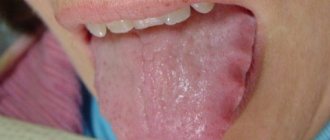Causes
The exact causes of the pathology are not fully understood. The disease is not an independent disease; it appears against the background of other diseases. Most often, this phenomenon occurs in men over 40 years of age, but is sometimes observed in women. This disease is very rare in children.
The pathology is most often observed in people with gastrointestinal dysfunction, ulcers and gastritis. The development of the disease is greatly facilitated by poor oral hygiene, smoking habits and excessive coffee consumption.
The main causes of the development of the disease are considered:
- long-term use of medications, especially antibiotics;
- fungal infections;
- dehydration;
- chemotherapy;
- metabolic disease;
- weakened immune system;
- Regular rinsing of the mouth with solutions containing astringents.
The risk group also includes people with dental defects and the absence of a large number of teeth, since in this case they are forced to eat only soft food, which does not have the proper abrasive effect on the surface of the tongue.
Geographical language: what to do if you are faced with desquamative glossitis?
The term “geographic tongue” or “desquamative glossitis” refers to inflammation of the mucous membrane of the tongue, accompanied by sloughing (desquamation) of the epithelium, as a result of which the surface of the tongue becomes covered with bright pink spots with a white rim. The spots are flat, have rounded, distorted outlines, which makes the tongue look like a geographical map. The sites of inflammation are mainly the lateral surfaces and the back of the tongue. Causes Desquamative glossitis is a relatively common disease, although the clear causes of its occurrence have not been fully identified. It is generally accepted that geographic tongue is the body’s response to internal diseases, most often from the digestive and circulatory systems. Other common factors influencing the appearance of desquamative glossitis include:
- heredity;
- oral diseases;
- acute infectious diseases;
- avitaminosis (lack of vitamins);
- puberty in a child;
- exudative diathesis;
- violation of the metabolism of B vitamins;
- autoimmune diseases (disorders of the human immune system);
- endocrine, hormonal changes in the body (pregnancy, menopause, menstruation);
- teething in children.
Symptoms At the beginning of the inflammatory process, grayish-white spots with a diameter of several millimeters appear on the tongue. The papillae in the center of these spots gradually peel off, forming a bright pink or reddish round area. The desquamation (desquamation) zone can be either single or multiple, and can change shape and location. As a rule, geographic tongue occurs without any individual sensations, and therefore is detected by chance as a result of examination of the oral cavity. Sometimes patients experience itching, tingling, changes in the sensitivity and taste of the tongue, which may be due to poor oral hygiene or consumption of irritating foods. Diagnosis Geographic tongue is most often a symptom of serious illnesses, therefore, when it appears, it is necessary to diagnose the gastrointestinal tract, circulatory system, as well as diseases that may be the root cause of desquamative glossitis. It is mandatory to prescribe a general analysis of urine and feces and collect anamnesis (information about previous diseases, living conditions of the patient, etc.). Sometimes geographic tongue develops in children during teething or during puberty in girls. In these cases, no diagnosis is made. Treatment If the patient does not experience pain or discomfort, then no special treatment is prescribed: the geographic tongue will go away on its own after eliminating the root cause of the disease. If you experience a burning sensation, pain or dry mouth, the following is recommended:
- carry out thorough sanitation of the oral cavity;
- exclude excessively spicy, salty, cold or hot foods from the diet;
- rinse your mouth with a decoction of sage, chamomile or St. John's wort;
- give up cigarettes and alcohol for a while;
- apply rosehip oil to the oral mucosa (contains beta-carotene, vitamins A, E, B3)
Prevention This disease requires several preventive measures:
- careful oral care;
- timely diagnosis of somatic diseases;
- Prevention of vitamin deficiency: try to diversify your diet with foods rich in B vitamins.
It is important to remember that desquamative glossitis is a symptom of other very serious diseases, so a person who discovers a geographic tongue should immediately consult a specialist.
Symptoms
Pathology is immediately detected during a visual examination by a dentist. In the initial stages of the disease, the presence of a foreign object in the mouth is felt, other unpleasant signs gradually appear, then the upper part of the tongue noticeably turns black. In advanced cases, the affected area occupies two-thirds of the tongue. The disease is accompanied by unpleasant odor from the mouth, changes in taste sensations, a metallic taste appears in the mouth, a feeling of tickling and soreness on the surface of the tongue, as well as causeless nausea. In rare cases, there is a burning sensation and severe itching.
Spots on the tongue
General information
The tongue is an important organ that influences the process of speech formation, and consequently, communicative functions and digestion.
However, in addition to this, the tongue is also a kind of “mirror” of the internal organs. Based on the condition of the tongue, a specialist can determine the presence of many diseases. Tongue stains are a common problem that people do not pay enough attention to. They can be of different shapes and colors, which makes it possible to suspect one or another disease that provokes their occurrence. The spots are white, red and blue. In addition, there are such concepts as “geographic tongue” - inflammation of the tongue, accompanied by peeling of the surface layer, and “bald tongue” - the formation of spots on the tongue that are areas of dying papillae.
It should be understood that each of these pathologies is not a cosmetic problem, but a symptom of a disease, and in some cases quite serious and dangerous.
Causes
White spots on the tongue in most cases are a sign of the following diseases:
- candidiasis or thrush (can be localized not only in the vagina, as many believe, but also on the mucous membrane of the mouth. Quite often, a white coating on the tongue is the result of a fungal infection. When you try to clean off such plaque, you can find bleeding ulcers underneath);
- diseases of the gastrointestinal tract (a whitish coating on the tongue is a clear sign of problems in the gastrointestinal tract. In most cases, its appearance indicates the presence of chronic diseases of the stomach and duodenum).
Red spots on the tongue can form due to the following pathologies:
- tongue injury (a cut or biting the tongue can leave behind a red spot, slightly painful when pressed, which goes away on its own after some time);
- exudative erythema (the presence of this disease is indicated by the appearance of red spots on the tongue, surrounded by bubbles with a yellowish liquid. Over time, the bubbles can turn into ulcers);
- herpes virus (although most often red spots with herpes appear on the face and lips, the tongue is also no exception. The appearance of such spots indicates a significant decrease in immunity);
- other viral infections (red dotted spots - petechiae - on the tongue indicate the presence of a viral infection and reduced local immunity).
Dark spots on the tongue (brown or almost black) are a sign of serious pathologies. Their reasons are:
- tongue cancer;
- necrosis.
The appearance of blue spots on the tongue can be caused by the following factors:
- hemangioma (benign tumor);
- disturbances in the functioning of the cardiovascular system (especially in chronic heart failure).
Also, the appearance of spots on the tongue can be a consequence of dental problems (stomatitis, gingivitis).
The appearance of “bald” areas on the tongue is a consequence of a severe burn or large-scale trauma to the tongue, since the areas of the tongue damaged in this way are overgrown with connective tissue that does not have papillae.
“Geographical language” is a rather rare phenomenon. The reasons for its occurrence are not reliably known, but in most cases this symptom occurs with pathologies of the digestive system, childhood diathesis and blood diseases.
Treatment
It is necessary to contact a dentist or maxillofacial surgeon with such a problem. To obtain a complete clinical picture, it is necessary to undergo examination by a gastroenterologist, infectious disease specialist, endocrinologist and neurologist. Since the pathology develops against the background of other diseases, a comprehensive treatment regimen is used.
Only treatment of concomitant diseases, professional cleaning and treatment of the oral cavity, taking multivitamin complexes, antifungal medications and, if necessary, sedatives will help eliminate this unpleasant defect. Removal of heavily overgrown papillae can be carried out by cryodestruction (exposure to the pathological focus with liquid nitrogen). It is also necessary to adjust your diet, enriching it with foods with fiber, vitamins and minerals.
The prognosis for black hairy tongue is usually favorable. Elimination of causative factors, as well as appropriate comprehensive treatment of the disease, leads to complete restoration of the surface of the tongue.
Which doctor should you contact?
Few people know which specialist to contact if their tongue becomes stained. In fact, a whole group of doctors can help establish the cause of the disease and get rid of it: a dermatovenerologist, an ENT doctor, a surgeon, a dentist, a pulmonologist, a gastroenterologist and others. The first thing the patient should do is visit a therapist or dentist, who, if necessary, will refer him to a more specialized specialist.
Any pathology, be it small red dots or redness of the entire surface of the tongue, requires timely consultation with a competent doctor.
Prevention
As such, there is no prevention of black villous tongue. Even with good oral hygiene, you can encounter a similar phenomenon, but with timely treatment of diseases that lead to the development of such a complication, you can minimize the likelihood of the disease occurring.
The following rules must also be observed:
- thoroughly brush your teeth, gums and tongue with a soft brush;
- It is necessary to drink enough water, because if there is a lack of hydration in the oral cavity, it begins to develop; bacteria;
- reduce coffee consumption and quit smoking and alcoholic beverages.
The disease recurs quite rarely. During an exacerbation, the patient is advised to follow a gentle diet; food should be warm and soft in consistency.
What changes can there be in the language?
Every morning and evening, after brushing your teeth, it is necessary to examine the oral cavity for pathological changes. The procedure, which only takes one or two minutes, helps to avoid serious illnesses. If a red spot appears on the tongue, it may indicate the development of an allergic reaction, internal or local infectious pathology. With such a symptom you should consult a doctor.
The tongue of a healthy person should be uniformly pink in color, without changes in relief, moist, clean, not enlarged, painless, and moderately sensitive. Pathological changes can be very diverse - from simple redness to ulceration. Here are the main ones:
- neoplasms;
- itching;
- plaque;
- color change;
- ulcers;
- dashes;
- spots of various colors;
- wounds;
- plaques.
It must be remembered that many changes in the language appear for serious reasons and may not be very noticeable at first. Some, such as plaque or discoloration, may not cause discomfort to a person, but this is not a reason to let the situation take its course. The most common problem is stains.
Where does the pip on the tongue come from?
Initially, pip was considered a bird disease.
All birds have a growth on their beak that helps them peck food. Sometimes it becomes inflamed, accompanied by symptoms similar to diphtheria. This is a tipun. People call this a hard pimple on the tongue that appears as a result of damage or weakened immunity. Of course, there is also a medical term for this disease - glossitis. Interesting fact. According to popular beliefs, pipuns were considered a sign of deceit and appeared in the language of deceivers and foul-mouthed people.
The cause of pip may be mechanical damage to the tongue or weakened immunity by another disease.
In the first case, inflammation may appear after injury to the tongue (for example, a fish bone or seed), an insect bite, or a burn. You can even scratch the surface with a candy cane. In the second case, glossitis may be accompanied by a cold, gastrointestinal problems, dysbacteriosis, infectious diseases, and helminthic infestation.
Often, ulcers on the tongue occur due to dental diseases or improperly installed fillings, crowns or braces. In this case, you need to contact your dentist to correct the defects. Another way out is to prefer Invisalign aligners to metal braces: they do not injure the mucous membrane, acting gently and carefully.
There are also unobvious, but no less important causes of the disease:
- Bad habits. It is quite possible to “catch” a tongue tip at a party, because alcohol corrodes the soft tissues of the tongue, and nicotine corrodes the mucous membrane.
- Avitaminosis. Yes, a pimple in the mouth can pop up due to a lack of vitamins in the body and a generally weakened immune system. Therefore, pregnant women often suffer from this disease.
- Insufficient oral hygiene. Many people forget that they need to clean not only their teeth, but also their tongue, because no less germs accumulate on it. In addition, people who use braces may encounter this problem, since hygiene becomes more complicated with metal structures.
The pip can also be triggered by an allergic reaction to certain foods or hygiene products. This once again proves: choosing aligners means taking care of your health: they are hypoallergenic, easy to handle and do not interfere with normal high-quality oral hygiene.
As a rule, the symptoms of glossitis are not long in coming. It becomes painful for a person to chew and swallow, to talk, the tongue swells, goes numb, becomes loose and changes color. If you do not treat immediately, inflammation of the deep tissues of the tongue may begin, and ulcers may appear. At an advanced stage, glossitis can spread to the lips, cheeks and throat. By the way, despite this, it is a non-contagious disease. But it’s unlikely that you’ll want to kiss anyone with mouth ulcers.










